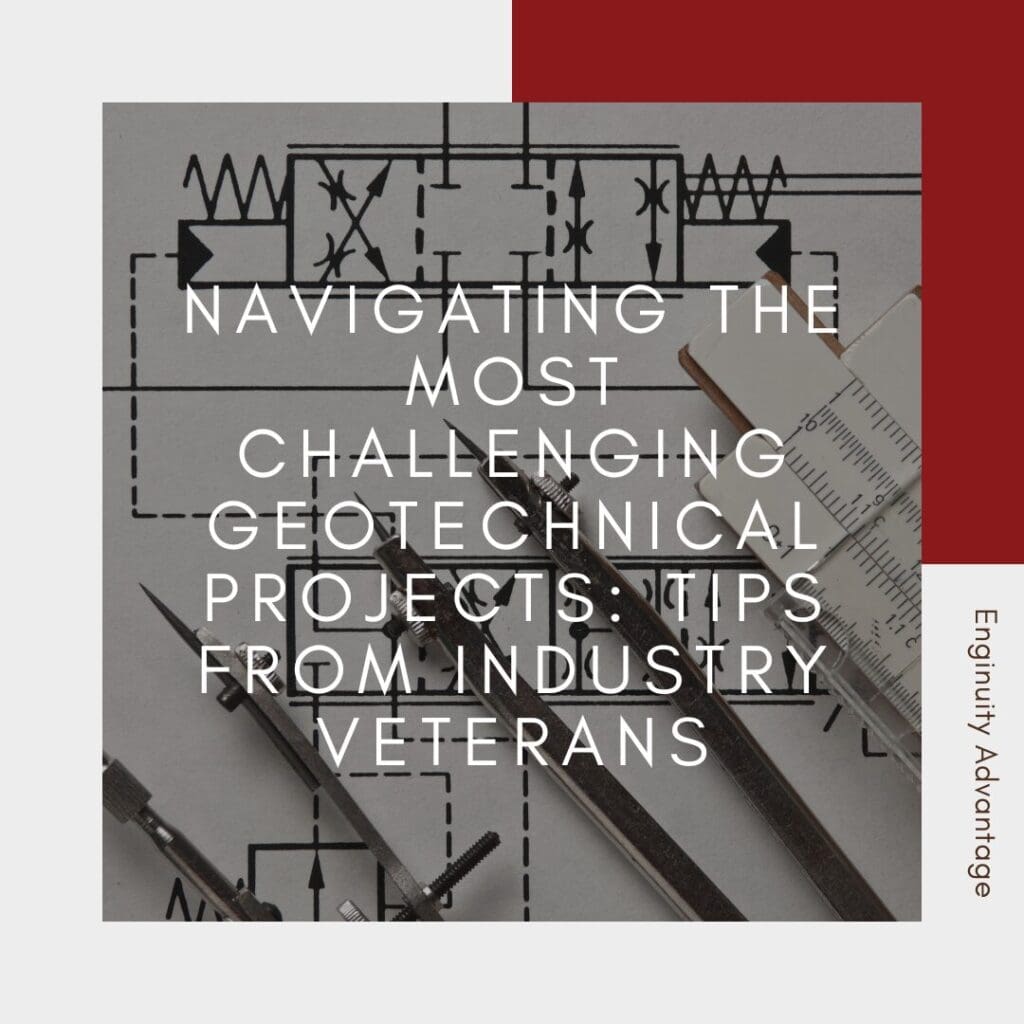Navigating the Most Challenging Geotechnical Projects: Tips From Industry Veterans

Geotechnical engineering is one of the most dynamic and complex fields in civil engineering, requiring expertise in soil behavior, rock mechanics, groundwater flow, and structural interaction. Every project presents unique challenges that demand specialized solutions, making adaptability and experience critical for success. Industry veterans understand that unforeseen ground conditions, environmental factors, and technological limitations must be met with creativity, precision, and sound engineering judgment.
This comprehensive guide explores the most challenging geotechnical projects, the common obstacles encountered, and expert strategies to overcome them. Whether dealing with soft ground, deep excavations, seismic risks, or extreme weather conditions, geotechnical engineers must navigate these challenges with meticulous planning, cutting-edge technology, and a strong foundation in geotechnical principles.
Understanding the Complexity of Geotechnical Engineering
Geotechnical engineering involves working with natural materials, soil, rock, and groundwater—that exhibit unpredictable behavior. Unlike manufactured materials, such as steel or concrete, soil and rock properties can vary significantly within short distances. Engineers must account for this variability when designing foundations, slopes, tunnels, or other critical structures.
External factors further complicate geotechnical projects. Seismic activity, groundwater fluctuations, climate change, and land-use pressures all play a role in determining soil stability. Engineers must use a combination of empirical data, advanced modeling techniques, and field expertise to assess risks and ensure long-term stability.
Major Challenges in Geotechnical Projects
Dealing with Weak or Unstable Soils
Weak or unstable soils present one of the biggest hurdles in geotechnical engineering. Whether working with soft clays that compress excessively, loose sands that lack cohesion, or organic soils that shift unpredictably, engineers must find ways to improve ground stability before construction begins. The consequences of ignoring weak soil conditions can be dire—excessive settlement, foundation failures, and structural instability. To combat these risks, engineers employ techniques like deep foundations, compaction grouting, and soil mixing to enhance soil strength and load-bearing capacity. These solutions must be tailored to the specific site conditions, ensuring that the right method is applied for each project.
Managing Groundwater and Drainage Issues
Water is one of the most unpredictable elements in geotechnical projects. High groundwater levels can weaken foundations, create hydrostatic pressure on retaining walls, and contribute to slope failures. If not properly managed, water-related issues can turn an otherwise stable site into a high-risk construction zone. Engineers address these challenges through dewatering systems, sub-surface drainage networks, and impermeable barriers. Additionally, considering seasonal variations and climate change projections is essential to designing long-lasting solutions that prevent water-related damage.
Ensuring Stability in Seismic Zones
In earthquake-prone areas, the ground itself can become a significant hazard. Liquefaction, where saturated soil temporarily loses its strength during seismic shaking—poses a major threat to buildings and infrastructure. Engineers working in these regions must reinforce foundations, use flexible structural connections, and incorporate damping systems that reduce seismic impact. Through extensive site-specific seismic hazard analyses, engineers can better predict ground behavior and implement designs that maximize resilience. Structural reinforcement, deep pile foundations, and soil densification are just a few of the many strategies used to mitigate earthquake damage.
Excavating in Urban Environments
As cities grow, construction is increasingly taking place in densely populated urban areas where space is limited. Deep excavations are required for subways, high-rises, and underground utilities, but they must be carefully planned to prevent structural movement in neighboring buildings. Engineers rely on shoring systems like sheet piles, diaphragm walls, and tieback anchors to stabilize excavation sites. Additionally, real-time monitoring using sensors and inclinometers ensures that excavation activities do not trigger unexpected ground movement that could compromise surrounding infrastructure.
Addressing Climate Change Impacts
Geotechnical engineers must now design with climate change in mind. Rising sea levels, shifting precipitation patterns, and more frequent extreme weather events have made resilience a key consideration in geotechnical projects. Engineers are integrating elevated foundations, reinforced drainage systems, and erosion-resistant materials into their designs to counteract these evolving risks. The unpredictability of future climate conditions requires geotechnical engineers to be more forward-thinking than ever before, anticipating long-term environmental changes and adapting their designs accordingly.
Advanced Strategies for Overcoming Geotechnical Challenges
Enhancing Foundation Design Techniques
The right foundation is essential for maintaining the stability of any structure, but geotechnical engineers must customize foundation solutions based on the specific challenges of a project. Deep foundations, such as drilled shafts and piles, provide extra stability in areas with weak surface soils. Engineers are also exploring newer foundation solutions, such as floating foundations in marshy terrain and micro piles in restricted urban spaces, to overcome space and soil limitations.
Applying Geosynthetics in Soil Stabilization
Soil stabilization has evolved significantly in recent years with the increased use of geosynthetics. These materials—including geotextiles, geomembranes, and geogrids—are used to reinforce soil, prevent erosion, and improve load distribution. Geosynthetics have proven especially useful in road construction, retaining walls, and embankment reinforcement. By integrating these materials into their designs, engineers can create more durable, cost-effective, and environmentally friendly solutions to common geotechnical challenges.
Utilizing Smart Monitoring Systems
Geotechnical engineers are increasingly turning to technology for real-time monitoring of construction sites. IoT-enabled sensors embedded in the ground can track movements, detect moisture variations, and measure stress levels in real time. This data allows engineers to detect potential issues before they become critical, making proactive adjustments to prevent failures. The ability to monitor site conditions remotely has also improved project efficiency, reducing the need for constant on-site inspections while maintaining safety and accuracy.
Case Studies: Lessons Learned from Complex Geotechnical Projects
Coastal Deep Foundation Challenges
Constructing buildings and infrastructure near coastlines presents a unique set of geotechnical difficulties. Loose, water-saturated sediments make for poor foundation material, and rising sea levels add to the complexity. Engineers working in these conditions rely on deep-sea piling techniques, cofferdams, and soil stabilization measures to prevent settlement and structural failure. Learning from past projects in coastal environments has led to significant advancements in foundation engineering.
Infrastructure Development in Permafrost Regions
Permafrost presents extreme challenges for geotechnical engineers, as it undergoes seasonal freeze-thaw cycles that can cause significant ground movement. Engineers designing structures in Arctic and sub-Arctic regions have developed innovative stabilization methods, including thermosyphon technology to keep permafrost frozen and specialized insulated foundations that minimize temperature fluctuations. Studying how previous projects have handled these issues allows engineers to refine their approaches for future developments in cold climates.
Mega Tunneling Projects and Subsurface Complexity
Tunneling projects require an advanced understanding of subsurface conditions. Engineers planning subway systems and underground reservoirs must navigate through highly variable ground conditions, ensuring that tunnels do not collapse or cause excessive ground settlement. Techniques such as tunnel boring machines (TBMs), rock bolting, and sequential excavation methods help mitigate risks and ensure successful underground construction.
The Future of Geotechnical Engineering
As the demand for resilient infrastructure grows, geotechnical engineers must continue to innovate. Future advancements will likely include bio-engineered soil stabilization techniques, carbon-neutral construction materials, and AI-driven predictive modeling. Additionally, digital twin technology is expected to play a major role in geotechnical engineering, allowing engineers to create virtual models of construction sites that update in real time.
Mastering Geotechnical Challenges for Long-Term Success
Navigating complex geotechnical projects requires a balance of experience, technical knowledge, and adaptability. Engineers who embrace emerging technologies, refine their risk management strategies, and continuously expand their expertise will be at the forefront of the industry. As geotechnical engineering remains at the core of modern infrastructure development, those who master its challenges will be instrumental in shaping the built environment for generations to come.
Unlock Dream Careers & Elite Talent: Just One Click Away!


